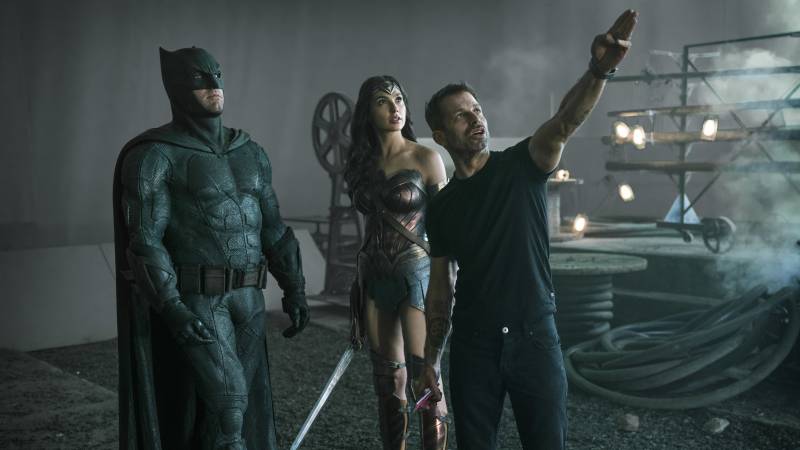When Snyder’s daughter died in early 2017, the director left Justice League‘s production and let Joss Whedon, director of Marvel’s first two Avengers movies, take over. Judging by Snyder’s version, Whedon must have completely retooled the film, creating a schizophrenic two-hour cut with loads of additional scenes which sometimes felt like two different movies playing at the same time.
With an avalanche of terrible reviews and a reported $300 million budget, the film lost many millions for Warner Bros. But passionate fans and some stars from the film kept hope alive—yes, there were billboards, social media campaigns and signs towed by airplanes—convincing Warner Media that releasing Snyder’s mega-version would bring a badly-needed superhero event to its corporate kin, streaming service HBO Max.
I may sound like the biggest of comic book/superhero story geeks, but it must be said: Zack Snyder’s Justice League is a much better movie. Especially since there are some critics—and film fans—who would likely prefer a bullet in the head than to sit through four hours of CGI-augmented fist fights and flying sequences.
Understand, I’m usually quite cynical about director’s cuts and expanded versions of theatrical releases. As much as I love James Cameron’s Aliens and the extra scenes he added in his director’s cut, the original theatrical release was a much leaner and focused story. After watching the new director’s cut of Francis Ford Coppola’s Godfather III, I wondered why he even bothered—none of its narrative problems were cured by Coppola’s new take.
Most theatrical releases contain the movie’s best scenes, regardless of what else gets tossed in through a director’s cut. But not so with Zack Snyder’s Justice League, which offers an entirely different narrative, different beginning, different ending and wider scope, to give a glimpse of the larger story he was driving towards all along. All this, married with the kind of dazzling visual sequences that once made Snyder the perfect custodian of the DC Extended Universe in film.
Gone is a lot of the hokey humor that Whedon seemed to insert to offset criticisms of Snyder’s relentlessly dark vision (Whedon’s name has also disappeared from this new film’s credits, suggesting they exorcised every bit of his material).
Superman and Cyborg don’t joke about getting knocked on their behinds at the film’s finish. Jason Momoa’s Aquaman and Batfleck—I mean, Ben Affleck’s Batman—don’t trade quips about how a son of Atlantis talks to fish. And, mercifully, a scene where Flash lands on Wonder Woman’s breasts after saving her from falling debris—an awkward bit of sexualization that star Gal Gadot reportedly refused to film, forcing Whedon to use a stunt double—has also been cut.
Snyder’s take is also an R-rated version. There is more blood and gore than typical big-budget superhero stories; Batman and other characters use the f-word and there is a scene where more than one hero actually murders a villain. Welcome to the Snyderverse.
It makes sense that a movie which exists because of the fans would work so hard to please them. So there are depictions of cool characters from the comics we haven’t yet seen on the big screen. Martian Manhunter and Deathstroke pop up, along with extended footage of supreme bad guy Darkseid and his lieutenants, like Granny Goodness.
Steppenwolf, the major villain of Justice League, is given a deadlier, less human look, and his mission to prepare Earth for Darkseid’s conquest—inspired by comic book legend Jack Kirby’s New Gods stories—is made more clear.
There are also expanded backstories on Ezra Miller’s Flash and Ray Fisher’s Cyborg; Fisher in particular gets to shine as we learn more about why Cyborg hates the father who used an alien machine to save his life after a horrific car accident, grafting unknown technology to his body.
And, of course, there’s a newly-filmed epilogue that leans toward the story of the Injustice graphic novel series. There’s a few surprises for fans, so I won’t detail much here; but it helps clarify a head-scratching moment from Batman v. Superman and includes a cameo from a character who remains a bit of a disappointment in the Snyder era of DC superhero films.
There are other problems here, too. This new Justice League is still packed with a lot of computer-generated effects that make the action feel unreal. Aside from Gadot’s Wonder Woman and the Amazons at the film’s start, the female characters here are mostly mopey and have little purpose beyond supporting the men.
The essential story—a group of misfit heroes must get out of their own way to team up and defeat a world-threatening villain backed by another, badder villain—is also the story from Marvel’s first Avengers‘ movie in 2012.
And it is four. Hours. Long. Frankly, this should have been a streaming project all along, given how much story Snyder wanted to cram into a theatrical feature. It’s tough to imagine audiences sitting in a theater for a movie this long, so you can’t help wondering what Snyder was thinking when he shot this much material in the first place.
Joss Whedon’s reputation has taken a hit since the original Justice League was released, with Fisher in particular alleging that Whedon was abusive on set and oversaw story changes which reduced or eliminated the roles of non-white characters in the film. (Indeed, Black characters like Cyborg’s parents and Flash’s love interest Iris West reappear or get more screen time in Zack Snyder’s Justice League).
Warner Bros. has denied Fisher’s allegations that executives there hindered an investigation into studio executives’ role in enabling Whedon. WarnerMedia announced in December that its investigation had concluded and unspecified “remedial action” had been taken.
It’s tough not to see Zack Snyder’s Justice League as a last-ditch attempt to rescue the film and its characters from the vortex of failure, toxic rumors and offscreen intrigue which seemed to surround the project for many years.

9(MDAxOTAwOTE4MDEyMTkxMDAzNjczZDljZA004))

